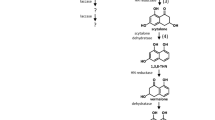Abstract
Evidence is presented suggesting that the sporulation ofS. fructicola probably proceeds by several phases. Light stimulates development of primordia but inhibits conidia formation.
“P310”, for the first time mentioned by Leach, does not have a sporogenic character. It is, however, a photo product of a metabolic substance formed by the fungus. The production of “P310” is much higher in mycelium cultivated in light of short wave-lengths and increases with the intensity of the light.
The “P310”-production is not common for all fungi. It is possible that the precursor for the photochemical reaction is missing in the mycelium of fungi, which do not produce the factor.
Samenvatting
De groeistadia vanSclerotinia fructicola werden bij het kweken in licht en donker bestudeerd. De groei begint met de vorming van hyfen in de agar, daarna treden de toppen van bepaalde hyfen boven de agar uit (primordia) en vormen conidioforen en conidiën. In continu donker verloopt dit proces zoals boven weergegeven, doch in continu licht (4800 Lux of hoger) wordt wel het mycelium in de agar gevormd en de primordia aangelegd, doch dan stopt het groeiproces. Bij lichtintensiteiten lager dan 4800 Lux vindt wel de vorming van conidioforen plaats. Deze verheffen zich boven de agar en zijn spaarzaam vertakt in tegenstelling tot de conidioforen, die in het donker gevormd worden. Deze zijn rijkelijk vertakt en vormen als het ware een mat op de agar.
De groiisnelheid van het mycelium is in licht en donker even groot.
Gaat aan de donkerperiode een lichtperiode vooraf, dan is deze van geen invloed op de sporulatie, mits de donkerperiode langer dan 48 uur duurt. Is deze korter, dan blijft het mycelium dat vóór de donkerperiode gevormd is, achter in sporulatie.
Licht voorfgaande aan een donkerperiode van 15 uur, stimuleert in het jongste mycelium de sporulatie. Het licht heeft zowel een stimulerende als een remmende invloed.
P310, voor het eerst door Leach vermeld, bleek geen sporegene stof; het is echter een stof, die onder invloed van licht ontstaat uit een stofwisselingsprodukt van de schimmel.
Bij de vorming van P310 is licht van kortere golflengte van groter invloed dan licht met langere golflengte en de P310-productie neemt toe met de intensiteit van het gebruikte licht.
De vorming van P310 komt niet voor bij alle fungi. Het is mogelijk dat de precursor voor de fotochemische reactie ontbreekt in het mycelium van deze schimmels.
Similar content being viewed by others
References
Aragaki, M., 1961. Radiation and temperature interaction on the sporulation of Alternaria tomato. Phytopathology 51: 803–805.
Aragaki, M., 1962. Quality of radiation inhibitory to sporulation of Alternaria tomato. Phytopathology 52: 1227.
Carlile, M. J., 1965. The photobiology of fungi. A. Rev. Pl. Physiol. 16: 175–202.
Cochrane, V. C., 1958. Physiology of fungi. Wiley, New York.
Gardner, E. B., 1955. Conidiophore elongation in Aspergillus giganteus: the influence of temperature, light intensity, and light quality. Trans. N.Y. Acad. Sci. Ser. II, 17: 476–491.
Gressel, J. & Galun, E., 1967. Morphogenesis in Trichoderma: Photoinduction and RNA. Devl Biol. 15: 575–598.
Hall, M. P., 1933. An analysis of the factors controlling the growth of certain fungi with special reference to Sclerotinia (Monilia) fructigena. Ann. Bot. 47: 538–578.
Hawker, L. E., 1956. Physiology of fungi. Univ. Lond. Press, London.
Jerebzoff, S., 1956. Action de la durée de la lumipériode sur la croissance des conidiophores fertiles et l'apparition des zonations chez Monilia fructicola (Wint.) Rehm. C. r. hebd. Séanc. Acad. Sci., Paris 242: 1059–1061.
Leach, C. M., 1961. The effect of near ultraviolet irradiation on the sporulation of certain fungi. Phytopathology 51: 65.
Leach, C. M., 1962a. Sporulation of diverse species of fungi under near ultraviolet radiation. Can. J. Bot. 40: 151–161.
Leach, C. M., 1962b. The quantitative and qualitative relationship of UV and visible radiation to the induction of reproduction in Ascochyta pisi. Can. J. Bot. 40: 1577–1602.
Leach, C. M., 1963. The qualitative and quantitative relationship of monochromatic radiator to sexual and asexual reproduction of Pleospora herbarum. Mycologia 55: 151–163.
Leach, C. M., 1965. Ultraviolet absorbing substances associated with light-induced sporulation in fungi. Can. J. Bot. 43: 185–200.
Lukens, R. J., 1965. Photo-inhibition of sporulation in Alternaria solani. Am. J. Bot. 50: 720–724.
Sagromsky, H., 1959. Zur lichtinduzierten Ringbildung. V. Nachklingen der Rhythmik bei Sclerotinia fructicola (Wint.) Rehm. Biol. Zbl. 78: 589–597.
Trione, E. J., Leach, C. M. & Mutch, J. T., 1966. Sporogenic substances isolated from fungi. Nature Lond. 212: 163–164.
Author information
Authors and Affiliations
Rights and permissions
About this article
Cite this article
Van Den Ende, G., Cornelis, J.J. The induction of sporulation in sclerotinia fructicola and some other fungi and the production of “P310”. Netherlands Journal of Plant Pathology 76, 183–191 (1970). https://doi.org/10.1007/BF01974329
Accepted:
Issue Date:
DOI: https://doi.org/10.1007/BF01974329




